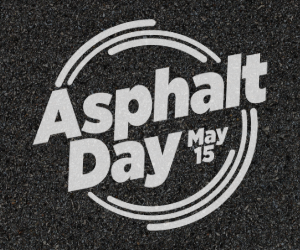Celebrating 75 years of Asphalt magazine
Part 2 (1975-1999)
Just like the industry it chronicles, “Asphalt” magazine saw transitions and evolved from 1975-1999.
After 28 years in a traditional magazine format, Asphalt Institute (AI) leaders decided in 1977 to experiment with a “maga-paper” style that was printed on glossy paper but folded like a newspaper. This version was called “Asphalt News” and featured smaller articles and industry updates.
The four-page tabloid-size publication was seen as an inexpensive way to continually communicate with Asphalt Institute members and the paving and roofing industry professionals around the world. AI field engineers and managing engineers agreed to continue to write the articles.
Official AI meeting minutes from 1977 called the format change “an inexpensive means of reaching engineers and designers who are not otherwise being contacted by the institute.”
This tabloid format was mailed out to 20,000 readers four times a year. Like the traditional magazine, there were many opportunities to promote other Asphalt Institute books for those who desired a more in-depth exploration of subjects.
In 1986 the AI Planning and Evaluation Committee accepted a staff proposal to return to the original magazine format for “Asphalt” magazine. Editor John Davis featured the new triangular logo of the Asphalt Institute on the cover of Asphalt magazine in the 16-page 1987 spring edition.
With that 1987 issue, the organization’s executive committee established a publication schedule of three issues a year and the spirit of the tabloid version carried on in the “Asphalt News” section of each issue devoted to brief items of importance.
Ultimately, the leadership agreed that a multi-page, stapled format “would be easier to handle and would more likely be retained.” The committee voiced grave concerns over accepting advertising at that time, so that decision was pushed until a later date.
Davis said the decision to return to the magazine format was very popular among the Asphalt Institute field engineers.
“Asphalt magazine centers on technology more than other magazines,” said Davis. “We are known for providing the truly technical particulars in asphalt paving and giving the whole story on the benefits of using asphalt on roads, streets and highways.”
The labor-intensive methods of designing and printing periodicals saw many changes in these 25 years. In 1985 the mailing list for the magazine was computerized. Desktop computer graphic design dramatically reduced the labor involved with creating a magazine in the late 1980s and 1990s. Gone were the days of typewriters, cutting columns with scissors then actually pasting the text on a page and taking large photographs of each layout before printing.
The first full-color cover for the magazine featured the Kennedy Expressway in Chicago, Illinois in the fall of 1987. It would be many years later before each page of the magazine was offered in full color.
The magazine included paid advertising for the first time in 1997. Ads for Koch Materials Company and Asphalt Materials, Incorporated, both Asphalt Institute member companies, let readers know about their new products and helped cover production costs and distribution.
Asphalt magazine played an active role in promoting Superpave throughout the 1990s. Superpave was named for a system of components that were intended to work together to provide a SUperior PERforming asphalt PAVEment. The new process was a result of the Strategic Highway Research Program (SHRP) 5-year research effort established by the U.S. Congress in 1987. At one point there was a “Superpave Corner” spotlight in every issue. The term was used on many covers and throughout the pages of the editions.
Other topics that were widely covered in the 1990s were rubblization, mix design developments and the emerging use of RAP (Reclaimed Asphalt Pavements). The magazine editors and Asphalt Institute leadership made every effort to keep up with the roofing and paving industries as the publication prepared for the 21st century.
Managing Editor Kendal Butler and Research Specialist Jacqueline D. Bartek collaborated on this article.
















